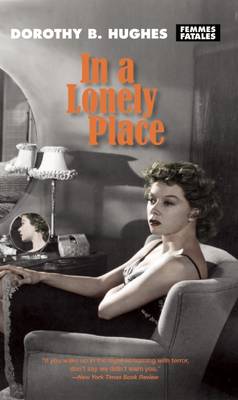Reviewed by Michael @ Knowledge Lost on
Dorothy B. Hughes is known for her crime novels, 14 books primarily in the Hard-Boiled and Noir genre and In a Lonely Place would be her most recognisable. This could be because of the Nicholas Ray adaptation starring Humphrey Bogart and Gloria Grahame or because of the psychological elements she brings to the genre. A lot of people will compare this novel with Patricia Highsmith’s The Talented Mr Ripley and while they are very similar I can’t help but thinking of the works of Jim Thompson as well. This might be because they all share the same influences Kafka, but more importantly Fyodor Dostoyevsky.
In a Lonely Place starts off like a typical noir novel and immediately the reader suspects there is something not quite right with Dix Steele. Could it be the fact that he is pretending to write a crime novel to sponge off his friends and family? Or the fact that he is a cynical misogynist? Maybe, but if you look a little closer at the writing you will find the answer. This is told in the first person but not by Dix Steele himself, like this person is with him at all times and sees everything Dix does. This sets up the psychological portrait of a woman-hating serial killer that really makes this novel work.
Towards the end of the book when Laurel Grey and the detective’s wife discover that Steele himself is the murderer, it comes as no great surprise. The book builds up like this big great reveal but there are so many elements throughout the book that give it away. I don’t think it was ever meant as a twist, just a way for Dix to find out himself. But through the whole book I was waiting and waiting for it to happen, I never really thought it would happen so late in the story.
The movie In a Lonely Place is vastly different to the book; for one thing Dix Steele is a successful screenwriter not a conman pretending to be a crime writer. Also true to Hollywood form, during the whole film everyone suspects Steele to be the killer but he turns out innocent. He still was a cynical vet but he never really had a chip on his shoulder towards the opposite sex, it felt like it was towards everyone. Also femme fatale Laurel Gray really wasn’t sassy or strong minded in the movie which was the biggest disappointment of them all.
Dorothy B. Hughes wanted to expose the misogyny of American society at that time with this book and she did a great job. The end result is this dark psychological tale that the movie adaptation butchered. Problem is I’ve seen the movie many times before finally reading the book, so it took me a long time to really get going. Both stories are worth checking out but trying to connect the film to the book doesn’t really do either of them any justice.
In a Lonely Place is worth reading; it’s nice to read a woman’s take on the noir genre. This really is a male dominated genre but women like Dorothy B. Hughes, Patricia Highsmith and Megan Abbott prove they can write noir just as well. The thing I loved most about this novel was that the influences of Fyodor Dostoyevsky’s Crime and Punishment were written all over this and yet Hughes made it her own. Make sure you check this novel out if you are a fan of Hard-Boiled, Noir or even psychological thrillers.
This review originally appeared on my blog; http://literary-exploration.com/2013/04/16/book-review-in-a-lonely-place/
Reading updates
- Started reading
- 8 March, 2013: Finished reading
- 8 March, 2013: Reviewed
